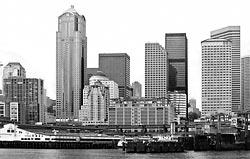Boxed In

LOOKING UP Madison Street from Elliott Bay, as we do here, it is still possible to see the "Big Black Box" that in 1968 began to define a new Seattle super-skyline. From most other prospects, the thicket of often-taller skyscrapers that have given Seattle its own modern cityscape have long since obscured what was originally the headquarters for Seattle First National Bank, R.I.P.
Lawton Gowey photographed the older view from a ferry on March 1, 1970. The Seattle Water Department accountant was good about recording the dates for the many thousands of pictures he took of his hometown.
The untoward size of the "Big Ugly" — another unkind name for it — can easily be grasped by comparing it to the Seattle Tower, the gracefully stepped dark scraper on the left. In the "now" it is more than hidden behind the 770-foot Washington Mutual Tower (1988). After its rise to 318 feet above Third Aveune and University Street in 1928, this Art Deco landmark was the second-highest structure in Seattle, following the 1914 Smith Tower. The 605-foot Space Needle moved both down a notch in 1962 and inspired the now old joke that we happily repeat. Soon after the Seafirst Building reached its shape in 1969 it was described as "the box the Space Needle came in." And at 630 feet it was big enough.
Many of Seattle's nostalgic old-timers consider the Seafirst Building the beginning of the end for their cherished "old Seattle." The more resentful among them say the central business district is now congested with oversized boxes that have obscured the more charming older landmarks. Some find solace in the waterfront, where a few of the railroad finger piers survive, including Ivar's Pier 54 seen on the far left in both views.
Paul Dorpat specializes in historical photography and has published several books on early Seattle.
